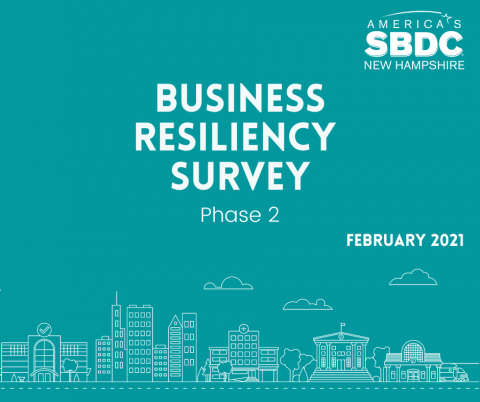
SBDC is excited to announce the results of the Phase 2 - Business Resiliency Survey, conducted together with the UNH Survey Center from February 1-19, 2021. Phase 2 received 1,611 responses from businesses in 174 cities and towns. Fifty-six business organizations partnered with the SBDC by sending an open-link email invitation to participate in the survey to their member businesses. The survey partners represented a wide range of industries, business associations, and regions.
Much has changed for small business owners since June 2020 according to the Phase 2 survey. Many new questions have emerged in terms of businesses’ current and anticipated future needs and challenges as they continue to navigate the COVID-19 pandemic. By leveraging SBDC’s survey results, New Hampshire's economic development partners can begin quantifying these issues and, in doing so, more effectively assist small businesses statewide.
“The effects of the pandemic are far from over. Small businesses will continue to need SBDC’s advising and education long into the future if we want to see the state’s economy recover to pre-pandemic levels,” said Liz Gray, state director of the NH SBDC.
NH sBDC Phase 2 Business resiliency survey report
Additional Subset Reports: Accommodation and Food Services Industry Report; Arts, Entertainment & Recreation Industry Report; Retail Trade Industry Report (more to come).
Press release: SBDC Statewide Survey Finds Small Businesses Cautiously Optimistic but In Need of More Relief in 2021
The survey results were presented to economic development partners on 3/10/2020. Watch the presentation on YouTube.
Phase 1: Results from the Phase 1 - Business Resiliency Survey
Phase 3: Results from the Phase 3 - Business Resiliency Survey
The NH SBDC Business Resiliency Surveys were made possible with funds from the CARES Act.
Key Findings
Nearly half of respondents say their business has reduced its hours of operation since the COVID-19 pandemic began and
one-third have closed temporarily. Most of those who reduced their hours say their business cut more than a quarter of their hours and half of those who closed temporarily say they did so for one to three months. Businesses that closed temporarily most often did so due to health and safety concerns, being required to close by government order, or due to a loss of revenue, while others report closing because they were homeschooling children or were caring for a family member, because of suspected or confirmed COVID-19 cases, or because employees were unable or unwilling to work.
The average respondent's business has just twelve employees which is largely unchanged since June but is down slightly
compared to mid-February 2020, when the average business had a reported average of just under fifeen employees. Nearly
half say they currently have the same number of employees as they did in February 2020 while three in eight report having
fewer employees.
Seventy percent of respondents say their business has seen its monthly revenue decrease as a result of the COVID-19
pandemic. While this proportion remains high, it has fallen since June 2020 (83%). Respondents cite the same top four factors as they did in June 2020 - a decline in sales, reduced hours of operation, being required to close, and supply chain interruptions - as the primary factors that have caused their business to experience financial losses, with a decline in sales clearly the most important factor. Three in eight say their accounts receivable have been slower as a result of the pandemic, down from nearly half in June, while a quarter report deferring or modifying their payments to vendors due to COVID-19, also lower than in June.
Three-quarters of respondents say their business applied for financial relief in 2020 and just over half plan to apply for relief in 2021. The Payroll Protection Program was by far the most commonly utilized federal relief program; nine in ten respondents say their business received it, while just over half received an Economic Injury Disaster Advance or Loan. Among state, municipal, and private relief programs, three-quarters received relief through unemployment for their employees and through the Main Street Relief Fund while nearly two-thirds received relief through unemployment for themselves. Use of unemployment for oneself or one's employees has increased dramatically since June 2020, when only about a quarter reported using these relief options. Overall, respondents are far more likely than in June 2020 to report that their business received relief from federal, state, municipal, and private sources.
Only one in six respondents say their business had a resiliency or continuity plan prior to the COVID-19 pandemic but another fifth of respondents say their business has developed one since. Larger businesses are more likely than others to have had a plan before the onset of the pandemic. Most businesses who do have a resiliency or continuity plan report lacking at least one important component of their plan.
Nearly two-thirds of respondents believe that resiliency planning will be very important or somewhat important to their
business in the future, including more than three-quarters of those with a plan but also a majority of those who say their
business currently lacks such a plan.
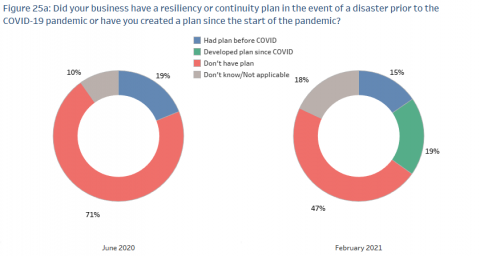
- Respondents whose business has more than twenty-five employees and those with employees working remotely are more likely than others to say that their business had a resiliency or continuity plan in the event of a disaster prior to the COVID-19 pandemic.
- Respondents in the health care and social assistance and the arts, entertainment, and recreation industries are more likely than others to say that their business developed a resiliency or continuity plan since the onset of the COVID-19 pandemic.
- Respondents whose business is located in Western NH are more likely than others to say that their business doesn't have a resiliency or continuity plan
As a result of COVID-19, just over half of respondents say their business has purchased PPE for their employees while four in
ten have maintained or brought employees back under the Payroll Protection Program and just over a third have changed the layout of their business to protect employees. Businesses are slightly more likely than in June to report having purchased PPE and changed the layout of their business. One in five businesses have some employees working remotely, unchanged since June 2020, with larger businesses more likely to do so.
Respondents also reported innovations and modifications that their business has implemented due to COVID-19 with more
than a quarter now offering new products or services, collaborating with other businesses, and using e-commerce.
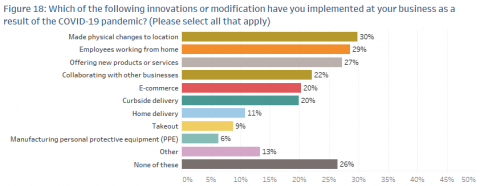
Figure 18
As a result of the COVID-19 pandemic, more than a quarter of respondents say their business made physical changes to their location (30%), have employees now working from home (29%), and are offering new products or services (27%), while just under a quarter are collaborating with other businesses (22%), engaging in E-commerce (20%), or offering curbside delivery (20%) as a result of COVID-19. Fewer respondents say their business now offers home delivery (11%) or takeout (9%) or say that their business is now manufacturing personal protective equipment (PPE) (6%). Thirteen percent say their business has implemented another innovation or modification as a result of the pandemic while 26% say their business has done none of these things.
When asked about one successful thing their business has done in response to COVID-19, respondents most frequently mention that they changed how they deliver or produce their products or that they protected the health of employees or customers, while others mention how they implemented remote or virtual work or practiced better external communication or advertising.
Nineteen percent of respondents say that their business is better off financially than they were in June 2020, 35% say they are
in about the same position financially, and 42% are worse off. Businesses in the health care and social assistance and the
manufacturing industries are more likely to say they are better off.
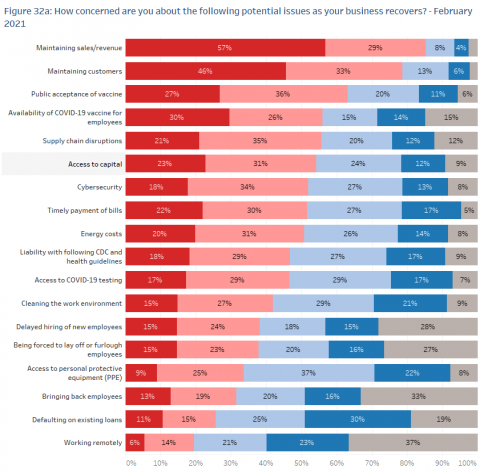
Eighty-five percent of respondents say that they are very (57%) or somewhat (29%) concerned about maintaining
sales/revenue as their business recovers, while 79% are very or somewhat concerned about maintaining customers. A majority of respondents are very or somewhat concerned about public acceptance of the COVID-19 vaccine (63%), the availability of the COVID-19 vaccine for their employees (56%), supply chain disruptions (56%), access to capital (54%), cybersecurity (52%), timely payment of bills (52%), and energy costs (51%) as their business recovers.
Less than half of respondents say they are concerned about liability with following CDC and health guidelines (47%), access to COVID-19 testing (47%), cleaning the work environment (42%), delayed hiring or new employees (38%), being forced to lay off or furlough employees (38%), and access to personal protective equipment (PPE) (34%). Less than a third are concerned about bringing back employees (32%), defaulting on existing loans (26%), or working remotely (20%).
As in June, maintaining sales and revenue and maintaining customers are by far the biggest concerns of respondents as their
businesses recover from COVID-19, followed by concerns about the availability of the COVID-19 vaccine for employees and
public acceptance of the vaccine. Majorities also are concerned about supply chain disruptions, access to capital, cybersecurity, timely payment of bills, and energy costs. Concern about timely payment of bills and access to PPE have declined since June but concern over access to COVID-19 testing and cybersecurity have increased.
Respondents most frequently cite renewed access to customers, health and safety guidance, financial assistance, and access to the COVID-19 vaccine for their employees as most important to their business in the future. Mirroring results in June 2020,
most businesses plan to continue the changes and innovations they made in response to COVID-19 even after the pandemic
has passed; more than three-quarters of those who are utilizing e-commerce, collaborating with other businesses, offering
takeout, offering new products or services, and having employees work from home plan to continue doing so.
Respondents are more confident than they were in June in the continued survival of their business in the short and long-term
as more than four in five respondents are confident their business will be operating in twelve months. Very small businesses,
those in Northern NH, and those in the arts, entertainment, and recreation industry are particularly more confident than they
were in June. Respondents are also more bullish than in June in their expectations for the recovery of the state's economy to
pre-pandemic levels. Few still believe that this will happen within three months, but more than seven in ten are confident it will happen within twelve months.
Overall, 1,611 businesses from 174 towns and cities responded to the survey. These businesses represented a wide variety of industries and sizes.
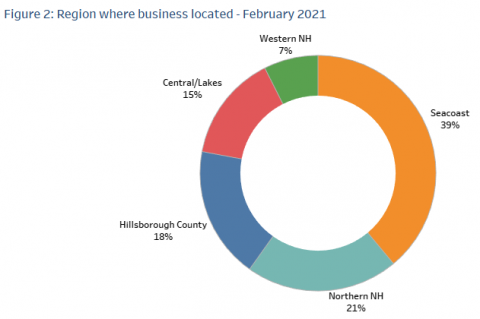
Figure 33: Overall, businesses from 174 towns and cities in New Hampshire responded to the survey. Thirty-nine percent of these respondents say their business is located in the Seacoast region, 21% are located in Northern NH, 18% are located in Hillsborough County, 15% are located in the Central/Lakes Region, and 7% are located in Western NH.
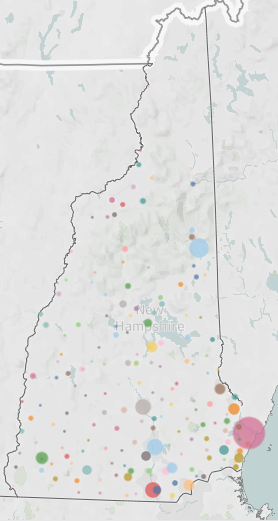
Figure 32: Towns where businesses that responded are located
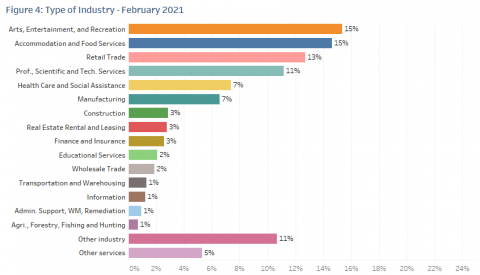
Fifteen percent of respondents each say their business is in the arts, entertainment, and recreation industry or in the
accommodation and food services industry, 13% are in the retail trade industry, 11% are in the professional, scientific, and technical services industry, and 7% each are in the health care and social assistance or manufacturing industries. Fewer respondents say their business is in the construction (3%), real estate rental and leasing (3%), finance and insurance (3%), educational services (2%), wholesale trade (2%), transportation and warehousing (1%), information (1%), administrative support, waste management, and remediation (1%), or agriculture, forestry, fishing, and hunting (1%) industries. Eleven percent say their business belongs to another type of industry while 5% say their business is part of another type of services
The downloadable abridged pdf report is available here:
NH SBDC phase 2 Business Resiliency Survey report
If you would like a link to the full report, please email nh.sbdc@unh.edu with your request.
Watch the survey results presentation (3/10/2020)on YouTube.
Thank you to the Phase 2 Survey Partners
- U.S. Small Business Administration - NH District Office
- NH Department of Business & Economic Affairs
- UNH Peter T. Paul College of Business & Economics
- New Hampshire Alliance of Regional Development Corporations
- Center for Women & Enterprise
- SCORE
- UNH Cooperative Extension
- UNH Center for Family Enterprise
- UNH Innovation
- Arts Alive
- Clean Energy NH
- Coworking House
- Goldman Sachs 10,000 Small Businesses
- Hannah Grimes Center
- HRKNSS
- League of NH Craftsmen
- New Market Business Association
- NH Aerospace & Defense Export Consortium
- NH Association of Chamber of Commerce Executives
- NH Business & Industry Association
- NH Businesses for Social Responsibility
- NH Grocers Association
- NH Lodging & Restaurant Association
- NH Made
- NH Retail Association
- NH State Council on the Arts
- NH Tech Alliance
- State Early Learning Alliance
- Stay Work Play
- Town of Derry, Economic Development
- UNH Career and Professional Success
- Upper Valley Business Alliance
- Wentworth Economic Development Corporation
- Central NH Chamber of Commerce
- Chamber Collaborative of Greater Portsmouth
- Exeter Area Chamber of Commerce
- The Falls Chamber of Commerce
- Greater Claremont Chamber of Commerce
- Greater Concord Chamber of Commerce
- Greater Derry Londonderry Chamber of Commerce
- Greater Dover Chamber of Commerce
- Greater Hudson Chamber of Commerce
- Greater Keene and Peterborough Chamber of Commerce
- Greater Manchester Chamber of Commerce
- Greater Merrimack-Souhegan Valley Chamber of Commerce
- Greater Nashua Chamber of Commerce
- Greater Pittsfield Chamber of Commerce
- Greater Rochester Chamber of Commerce
- Greater Salem Chamber of Commerce
- Hampton Area Chamber of Commerce
- Hooksett Chamber of Commerce
- Kearsarge Area Chamber of Commerce
- Lakes Region Chamber of Commerce
- Lake Sunapee Region Chamber of Commerce
- Meredith Area Chamber of Commerce
- Mt. Washington Valley Chamber of Commerce
- Northern Gateway Chamber of Commerce
- Twin Mountain Bretton Woods Chamber of Commerce
- Western White Mountains Chamber of Commerce
